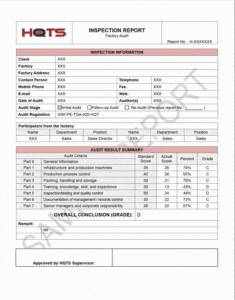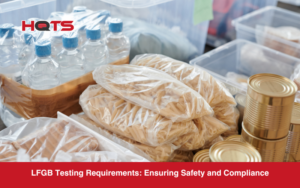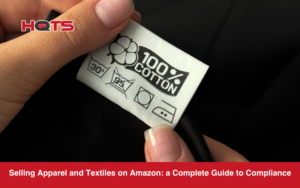Within today’s globalised market, there are many choices as to whom organisations choose to work with – and this is often the case when finding suppliers. But finding the right supplier can be challenging, especially if the actual company is located thousands of miles away from you. Luckily, supplier audits can help businesses overcome these challenges.
In this article, we’ll go through the key information you need to know regarding supplier audits.
What Is a Supplier Audit?
A supplier audit is basically an assessment (usually performed by a third party) to review the characteristics and capabilities of the supplier, as well as its compliance with industry regulations. This process covers the verification of standards, safety measures, and the correct execution of manufacturing processes.
Who Conducts a Supplier Audit?
Typically the supplier audits are conducted by a neutral third-party inspection company, and this organisation evaluates the supplier’s compliance on behalf of the buyer related to specific quality standards and client’s requirements. The supplier audits should be conducted every two years to ensure the supplier is up to standard.
What does a Supplier Audit Cover?
A supplier audit covers a variety of areas and practices, so it is usually tailored to the specific needs of each organization. This means that it can be tailored to the industry, whether it is food, electrical or other. Given the specialized nature of audits, these can be carried out internally by the company itself or by external entities, such as HQTS, which is more common. To ensure that the supplier continues to comply with established standards, audits are usually carried out every two years.
A basic factory audit or supplier audit includes:
- General information about the company
- Machinery and facilities (including security measures)
- Number of employees and organizational chart
- Certifications and technical capabilities of staff
- Legal information about the compan
- Production systems and quality control system
- Storage and packaging of the product
- Other points of interest requested by the client
Each of the above points is given a score. Once the above points have been analyzed, the auditor issues a report that includes a description of points of interest discovered during the audit and gives suggestions on how to resolve them.
If you want to get into details please check here a HQTS Sample Report of a Supplier Audit:
What Are the 3 Types of Supplier Audits?
Supplier audits can be broken down into three broader categories, namely: announced audits, unannounced audits and desktop audits. We’ve summarised the key points of each three audits below.

- Announced Supplier Audits
Announced supplier audits give the supplier a notice before they are conducted. Both parties agree on this before the inspection, allowing ample preparation time. Although this style is effective, it can somewhat lack transparency as the supplier have an opportunity to review their processes and improve them before they are audited.
- Unannounced Supplier Audits
Unannounced audits are performed on a supplier without first discussing the audit with the supplier or giving them prior knowledge of the inspection date. This is a trending inspection method, as it gives the buyer an insight into the daily operations and practices used onsite while ensuring that nothing has been tampered with or prepared beforehand (which can occur under announced visits).
- Desktop Supplier Audits
Desktop audits do not require an inspector to visit the supplier’s site in person. Instead, these audits are focused on verifying the supplier’s documentation and certificates are up to date. These can be things like the ISO 9001 certification, which certifies their quality management system to ensure they are up to the required and agreed level set out by the organisation collaborating with the supplier and governing bodies that regulate the industry.
How Do You Perform a Supplier Audit?
The procedure of performing a supplier audit typically involves examining the supplier’s business practices, financial history and product quality. But it is always bespoke to the buyers’ needs. Therefore, it can differ between supplier inspections.
But in general, a standard guideline is used. Below is a typical supplier audit checklist:
1. Pre Audit Questionnaire and Pre-inspection Meeting
It typically starts with pre-audit questionnaires that collect information regarding the supplier and the procedures. Followed by a pre-inspection meeting, where both parties discuss the audit process and agree on any changes to be made, allowing for a clear purpose and list of objectives before the auditing process.
2. Team Selection
From here, a team will be formed to best match the audit type. These staff members are chosen based on their expertise and knowledge of the type of supplier audit.
3. Notification of Audit to Supplier
A notification is given to the supplier in writing (with several months’ notice) to allow them to prepare. Written notifications also contain:
- The purpose of the audit
- The schedule of the inspection
- Names and details of the auditors
4. Pre-inspection Meeting
This involves a brief introduction to the auditors and finalising any changes to the inspection schedule.
5. Execution of Supplier Audit
After the meeting is adjourned, the inspection will begin in which the auditors will inspect each aspect of the brief using a supplier auditing checklist based on the original goals and objectives. This checklist comes in the form of an observation sheet (OS) which records the inspector’s findings.
6. Reporting on Findings and Closure of Audit
Once the audit is completed, the auditors will compare and discuss the findings. After which, they’ll create a report based on the inspection. This report includes assessing whether the supplier conforms to specific requirements and feedback for improvements.
How to Audit a Supplier by Yourself?
Auditing a supplier alone can be difficult if you don’t have the proper knowledge or experience. But there are certain factors to be aware of which can assist in producing a more robust audit. These things include:
Research Customer Complaints
Analysing customer complaints can be a great starting point to understanding the key danger points with a particular supplier. When you’re trying to decide if a new supplier or company is right for your business, asking previous customers of the provider or complaints which have been formally submitted can give insight into failures within the service. If there is repetitiveness within these complaints, it can indicate that the product or service is not up to standard.
Check if a Supplier Is Outsourcing
Suppliers can often outsource work to subcontractors to complete orders and provide for clients. Understanding if suppliers partake in this can help clarify their performance and, ultimately, their final product.
It is essential to ask whether or not they do use subcontractors and, if they do, whether there are valid quality agreements that align with your organisation’s requirements. As well as this understanding, the relationship between the supplier and its subcontractor can illuminate potential issues if the relationship is poor.
What Are the Benefits of Supplier Audits?
As companies grow the size of their supply chain, selecting the appropriate supplier is essential. A supplier’s reputation and quality will ensure that business runs smoothly and reduce potential issues or risks. Because of this, an audit of suppliers is essential to help in the decision-making process.
Some of the benefits of implementing a supplier audit are:
1. The Audit Reveals Potential Risks
A supplier audit can review all production processes, including shipping, manufacturing, and quality. They may give insight into gaps and check if these will cause any issues with the delivery to a client. Therefore potentially mitigating delays or deformities in the product.
2. Improves Customer Satisfaction
An organisation relies on its reputation with customers. This is done through the quality of the products put forth to them. Implementing strong standards and ensuring a supplier follows them allows for customer satisfaction to be upheld. A supplier audit can assist in the quality control processes of a supplier to potentially mitigate any product quality or safety issues. It is also a way for an organisation to measure the supplier’s performance.
3. Helps Build Communication With Suppliers
A supplier audit is also a way to improve and maintain strong communication with a supplier. Clear visibility and understanding of suppliers’ activities can assist with improvements and the business relationship. Regularly scheduled audits ensure objectives are met and can be constantly developed depending on the organisation’s needs.
What Is a Supplier Audit Report?
When supplier audits are conducted, an organisation follows a procedure to consistently measure supplier quality and compliance. This is recorded in a supplier audit report. This report contains all the details of the audit, this includes:
- Details of the factory, including the key team and location.
- A summary of the audit results.
- Key attention points provide more details regarding faults and general comments.
- A list of follow-up suggestions to improve the supplier.
- A full audit list includes general information and all the detailed inspection findings that work on an ABC quality scale.
- Finally, a section for images taken whilst on location provides evidence of any faults.
If you want to see an example of a supplier audit report, understand the format in more detail. Click below to download our free example.
HQTS Provides Supplier and Factory Audits Services around the globe
We at HQTS provide a range of high-quality supply chain innovations and solutions, including supplier audits. With over 25 years of experience within the quality control industry. We understand the importance of clear information for organisations to make valuable choices. We can help with a range of services, from PSI inspection services to audits and testing. Contact us to learn more about our supplier audit services and how we can help your organisation with its supply chain needs.





